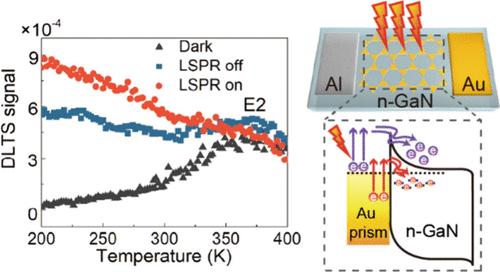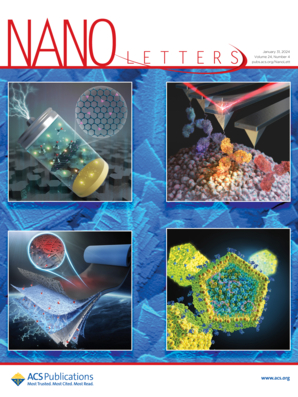Pushing the Limits of Photoconductivity via Hot Electrons in Deep Trap States in Plasmonic Architectures
IF 9.6
1区 材料科学
Q1 CHEMISTRY, MULTIDISCIPLINARY
引用次数: 0
Abstract
Although extensive research on the mechanisms of photoconductivity enhancement in plasmonic Schottky structures has been conducted, the photoconductive interplay between hot electrons and trapping states remains elusive. In this study, we explored the photoconductive relationship between plasmonic hot-carriers and defect sites present in plasmonic architectures consisting of N-face n-GaN and Au nanoprisms. Our experimental results clearly verified that the plasmonic hot-electrons generated by interband transitions preferentially occupied deep trap levels in n-GaN, thereby considerably enhancing the photoconductivity through the combination of photogating and photovoltaic effects. Our quantitative evaluation demonstrated that a mere 63% increase in hot-electron trapping leads to a 1.7-fold increased photocurrent under localized surface plasmon resonance (LSPR) excitation compared to the figure of photocurrent under non-LSPR stimulus. Our findings provide novel insights into the mechanisms of photoconductive enhancement for advanced plasmonic applications.

通过等离子体结构中深陷阱态的热电子推动光电导极限的发展
尽管人们对等离子肖特基结构的光电导增强机制进行了广泛的研究,但热电子与捕获态之间的光电导相互作用仍然难以捉摸。在本研究中,我们探索了由 N 面 n-GaN 和金纳米棱镜组成的等离子体结构中的等离子体热载流子与缺陷位点之间的光电导关系。我们的实验结果清楚地验证了带间跃迁产生的等离子体热电子优先占据了 n-GaN 中的深阱位,从而通过光ogating 和光电效应的结合大大提高了光导率。我们的定量评估结果表明,在局部表面等离子体共振(LSPR)激励下,热电子阱仅增加 63% 就能使光电流比非 LSPR 激励下的光电流增加 1.7 倍。我们的研究结果为先进的等离子体应用提供了光电导增强机制的新见解。
本文章由计算机程序翻译,如有差异,请以英文原文为准。
求助全文
约1分钟内获得全文
求助全文
来源期刊

Nano Letters
工程技术-材料科学:综合
CiteScore
16.80
自引率
2.80%
发文量
1182
审稿时长
1.4 months
期刊介绍:
Nano Letters serves as a dynamic platform for promptly disseminating original results in fundamental, applied, and emerging research across all facets of nanoscience and nanotechnology. A pivotal criterion for inclusion within Nano Letters is the convergence of at least two different areas or disciplines, ensuring a rich interdisciplinary scope. The journal is dedicated to fostering exploration in diverse areas, including:
- Experimental and theoretical findings on physical, chemical, and biological phenomena at the nanoscale
- Synthesis, characterization, and processing of organic, inorganic, polymer, and hybrid nanomaterials through physical, chemical, and biological methodologies
- Modeling and simulation of synthetic, assembly, and interaction processes
- Realization of integrated nanostructures and nano-engineered devices exhibiting advanced performance
- Applications of nanoscale materials in living and environmental systems
Nano Letters is committed to advancing and showcasing groundbreaking research that intersects various domains, fostering innovation and collaboration in the ever-evolving field of nanoscience and nanotechnology.
文献相关原料
| 公司名称 | 产品信息 | 采购帮参考价格 |
|---|
 求助内容:
求助内容: 应助结果提醒方式:
应助结果提醒方式:


